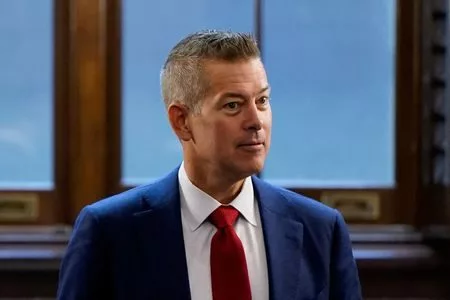NUKU’ALOFA, Tonga (AP) — Highlighting seas that are rising at an accelerating rate, especially in the far more vulnerable Pacific island nations, United Nations Secretary-General Antonio Guterres issued yet another climate SOS to the world. This time he said those initials stand for “save our seas.”
The United Nations and the World Meteorological Organization Monday issued reports on worsening sea level rise, turbocharged by a warming Earth and melting ice sheets and glaciers. They highlight how the Southwestern Pacific is not only hurt by the rising oceans, but by other climate change effects of ocean acidification and marine heat waves.
Guterres toured Samoa and Tonga and made his climate plea from Tonga’s capital on Tuesday at a meeting of the Pacific Islands Forum, whose member countries are among those most imperiled by climate change. Next month the United Nations General Assembly holds a special session to discuss rising seas.
“This is a crazy situation,” Guterres said. “Rising seas are a crisis entirely of humanity’s making. A crisis that will soon swell to an almost unimaginable scale, with no lifeboat to take us back to safety.”
“A worldwide catastrophe is putting this Pacific paradise in peril,” he said. “The ocean is overflowing.”
A report that Guterres’ office commissioned found that sea level lapping against Tonga’s capital Nuku’alofa had risen 21 centimeters (8.3 inches) between 1990 and 2020, twice the global average of 10 centimeters (3.9 inches). Apia, Samoa, has seen 31 centimeters (1 foot) of rising seas, while Suva-B, Fiji has had 29 centimeters (11.4 inches).
“This puts Pacific Island nations in grave danger,” Guterres said. About 90% of the region’s people live within 5 kilometers (3 miles) of the rising oceans, he said.
Since 1980, coastal flooding in Guam has jumped from twice a year to 22 times a year. It’s gone from five times a year to 43 times a year in the Cook Islands. In Pago Pago, American Samoa, coastal flooding went from zero to 102 times a year, according to the WMO State of the Climate in the South-West Pacific 2023 report.
While the western edges of the Pacific are seeing sea level rise about twice the global average, the central Pacific is closer to the global average, the WMO said.
Sea levels are rising faster in the western tropical Pacific because of where the melting ice from western Antarctica heads, warmer waters and ocean currents, UN officials said.
Guterres said he can see changes since the last time he was in the region in May 2019.
While he met in Nuku’alofa on Tuesday with Pacific nations on the environment at their leaders’ annual summit, a hundred local high school students and activists from across the Pacific marched for climate justice a few blocks away.
One of the marchers was Itinterunga Rae of the Barnaban Human Rights Defenders Network, whose people were forced generations ago to relocate to Fiji from their Kiribati island home due to environmental degradation. Rae said abandoning Pacific islands should not be seen as a solution to rising seas.
“We promote climate mobility as a solution to be safe from your island that’s been destroyed by climate change, but it’s not the safest option,” he said. Barnabans have been cut off from the source of their culture and heritage, he said.
“The alarm is justified,” said S. Jeffress Williams, a retired U.S. Geological Survey sea level scientist. He said it’s especially bad for the Pacific islands because most of the islands are at low elevations, so people are more likely to get hurt. Three outside experts said the sea level reports accurately reflect what’s happening.
The Pacific is getting hit hard despite only producing 0.2% of heat-trapping gases causing climate change and expanding oceans, the UN said. The largest chunk of the sea rise is from melting ice sheets in Antarctica and Greenland. Melting land glaciers add to that, and warmer water also expands based on the laws of physics.
Antarctic and Greenland “melting has greatly accelerated over the past three to four decades due to high rate of warming at the poles,” Williams, who was not part of the reports, said in an email.
About 90% of the heat trapped by greenhouse gases goes into the oceans, the UN said.
Globally, sea level rise has been accelerating, the UN report said, echoing peer-reviewed studies. The rate is now the fastest it has been in 3,000 years, Guterres said.
Between 1901 and 1971, the global average sea rise was 1.3 centimeters a decade, according to the UN report. Between 1971 and 2006 it jumped to 1.9 centimeters per decade, then between 2006 and 2018 it was up to 3.7 centimeters a decade. The last decade, seas have risen 4.8 centimeters (1.9 inches).
The UN report also highlighted cities in the richest 20 nations, which account for 80% of the heat-trapping gases, where rising seas are lapping at large population centers. Those cities where sea level rise in the past 30 years has been at least 50% higher than the global average include Shanghai; Perth, Australia; London; Atlantic City, New Jersey; Boston; Miami; and New Orleans.
New Orleans topped the list with 10.2 inches (26 centimeters) of sea level rise between 1990 and 2020. UN officials highlighted the flooding in New York City during 2012’s Superstorm Sandy as worsened by rising seas. A 2021 study said climate-driven sea level rise added $8 billion to the storm’s costs.
Guterres is amping up his rhetoric on what he calls “climate chaos” and urged richer nations to step up efforts to reduce carbon emissions, end fossil fuel use and help poorer nations. Yet countries’ energy plans show them producing double the amount of fossil fuels in 2030 than the amount that would limit warming to internationally agreed upon levels, a 2023 UN report found.
___
Borenstein reported from Kensington, Maryland.
___
Follow Seth Borenstein and Charlotte Graham-McLay on X at @borenbears and @CGrahamMcLay
___
Read more of AP’s climate coverage at http://www.apnews.com/climate-and-environment
___
The Associated Press’ climate and environmental coverage receives financial support from multiple private foundations. AP is solely responsible for all content. Find AP’s standards for working with philanthropies, a list of supporters and funded coverage areas at AP.org.
Brought to you by www.srnnews.com








